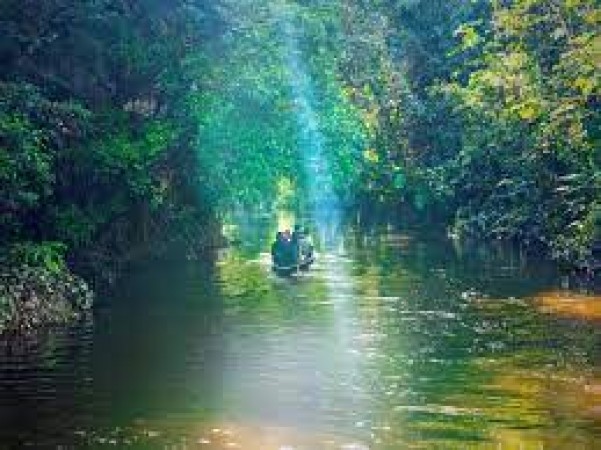
The Amazon River, often referred to as the "lifeline of the rainforest," is one of the most iconic and ecologically significant rivers in the world. With its immense size, incredible biodiversity, and cultural importance, the Amazon River has captured the imagination of explorers, researchers, and tourists alike. This article takes a deep dive into the marvels of the Amazon River, shedding light on its history, unique features, threats, and conservation efforts.
Overview of the Amazon River
Geographical Location
The Amazon River flows through South America, making its way through nine countries: Brazil, Colombia, Peru, Venezuela, Ecuador, Bolivia, Guyana, Suriname, and French Guiana. The river's vast network of tributaries covers approximately 6.7 million square kilometers, spanning a significant portion of the continent.
Length and Drainage Basin
Stretching over 6,575 kilometers (4,086 miles), the Amazon River is the second-longest river globally, after the Nile. Its drainage basin, known as the Amazon Basin, is the largest in the world, covering about 7 million square kilometers (2.7 million square miles). This immense basin plays a crucial role in regulating the Earth's climate and is often referred to as the "lungs of the planet" due to its role in absorbing carbon dioxide and releasing oxygen.
Biodiversity
The Amazon River and its surrounding rainforest harbor unparalleled biodiversity. Thousands of plant and animal species call this region home, many of which are found nowhere else on Earth. From jaguars and anacondas to vibrant macaws and elusive spider monkeys, the Amazon teems with life. The river itself is home to numerous aquatic species, including the iconic Amazon River dolphin and the gentle Amazonian manatee.
Historical Significance
Indigenous People and Early Explorers
The Amazon River basin has been inhabited by indigenous tribes for thousands of years. These tribes have a deep spiritual connection to the land and have developed intricate knowledge of the rainforest's resources. In more recent history, European explorers like Francisco de Orellana and Gonzalo Pizarro ventured into the heart of the Amazon in search of riches and adventure, paving the way for increased knowledge about the region.
Economic Importance
The Amazon River has been a vital economic artery for the communities residing along its banks. It serves as a transportation route, facilitating trade and commerce, especially for remote settlements that lack road connectivity. Additionally, the river's fertile floodplains support agriculture, enabling the growth of crops like rice and rubber.
Exploration and Navigation
Despite its historical significance, the Amazon River remains challenging to navigate due to its ever-changing water levels and strong currents. Over the years, several expeditions have faced adversity while attempting to traverse its course, leaving behind tales of courage and determination.
Unique Features and Natural Wonders
Amazon Rainforest
The Amazon River is synonymous with the Amazon Rainforest, the largest tropical rainforest on the planet. This vast expanse of greenery is home to an astonishing array of plant and animal species, and it plays a vital role in regulating the global climate.
Amazon River Dolphins
The Amazon River is home to unique pink and gray river dolphins, also known as boto and tucuxi, respectively. These intelligent and elusive creatures have captured the fascination of researchers and tourists alike.
Amazonian Manatees
Another remarkable resident of the Amazon River is the Amazonian manatee, a gentle herbivorous mammal. Sadly, the manatees face threats from human activities, making conservation efforts crucial for their survival.
Threats and Conservation Efforts
Deforestation and Habitat Loss
One of the most significant threats to the Amazon River and its surrounding rainforest is deforestation. Illegal logging, agricultural expansion, and infrastructure development have led to the loss of vast stretches of precious habitat, endangering countless species.
Pollution and Climate Change
Pollution, including oil spills and plastic waste, poses a threat to the delicate ecosystem of the river. Furthermore, climate change, driven by human activities, has far-reaching consequences for the Amazon River basin, including changes in rainfall patterns and increased frequency of extreme weather events.
Conservation Initiatives
Recognizing the urgent need to protect the Amazon River and its biodiversity, numerous conservation organizations and governments are working together to implement sustainable practices, protect indigenous rights, and create protected areas.
The Amazon River as a Cultural Icon
Influence on Art and Literature
The Amazon River and its surrounding rainforest have inspired countless works of art, literature, and music. Writers, painters, and musicians have sought to capture the mystique and grandeur of this natural wonder.
Mythology and Folklore
Throughout history, indigenous tribes living along the Amazon River have woven rich myths and folklore around its waters, animals, and spirits. These tales continue to shape the cultural identity of the region's inhabitants.
Tourism and Adventure Opportunities
River Cruises and Wildlife Tours
Tourism along the Amazon River offers a chance to explore its beauty up close. River cruises and wildlife tours provide travelers with the opportunity to spot exotic animals, discover remote villages, and immerse themselves in the splendor of the rainforest.
Adventure Sports and Activities
For adventure enthusiasts, the Amazon River presents opportunities for activities like kayaking, fishing, and even jungle trekking. These experiences allow visitors to connect with nature in its purest form.
Sustainable Tourism Practices
While tourism can be a source of income for local communities, it also brings the risk of environmental degradation. Emphasizing sustainable tourism practices is vital to ensure that future generations can continue to marvel at the Amazon's wonders. The Amazon River stands as a testament to the awe-inspiring diversity and resilience of our planet's ecosystems. Its significance goes beyond geography, playing a crucial role in climate regulation and cultural identity. As we face the challenges of preserving this precious natural resource, it is essential to remember that the fate of the Amazon River is intertwined with our own.
Birthday Special - Wishing the Man of Melodious Voice, Sonu Nigam!